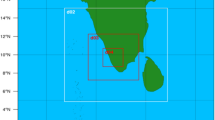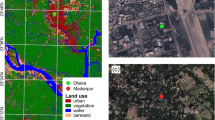Abstract
In spite of many experimental and theoretical studies the relationships between storm dynamics, severe weather, and lightning activity have been least understood. Measurements of electric field made under a severe thunderstorm at a northeastern Indian station, Guwahati, India are reported. Lightning flash rate increases drastically to about 84 flashes per minute (fpm) during the active stage which lasted for about 7 minutes, from about 15 flashes per minute during the initial phase of thunderstorm. Sudden increase in lightning flash rate (‘lightning jump’) of about 65 fpm/min is also observed in the beginning of the active stage. The dissipating stage is marked by slow and steady decrease in lightning frequency. Despite very high flash rate during the active stage, no severe weather conditions are observed at the ground. It is proposed that the short duration of the active stage might be the reason for the non-observance of severe weather conditions at the ground. Analysis of Skew-t graph at Guwahati suggests that vertical distribution of Convective Available Potential Energy (CAPE) also may play some role in non-occurrence of severe weather at ground in spite of large lightning flash rate and lightning jump observed in this thunderstorm. Further, all electric field changes after a lightning discharge indicates the presence of strong Lower Positive Charge Centers (LPCC) in the active and dissipation stages. This suggests that LPCC plays an important role in initiation of lightning discharges in these stages.
Similar content being viewed by others
References
Brook M, Nakano M, Krehbiel P and Takeuti T 1982 The electrical structure of the Hokuriku winter thunderstorms; J. Geophys. Res. 87 1207–1215.
Bourscheidt V, Juniora O P, Naccarato K P and Pintoa I R C A 2009 The influence of topography on the cloud-to-ground lightning density in South Brazil; Atmos. Res. 91 508–513.
Deaver L and Krider E 1991 Electric fields and current densities under small Florida thunderstorms; J. Geophys. Res. 96 D12, doi: 10.1029/91JD02264.
Deierling W and Petersen W A 2008 Total lightning activity as an indicator of updraft characteristics; J. Geophys. Res. 113 D16210, doi: 10.1029/2007JD009598.
Goswami B B, Mukhopadhyay P, Mahanta R and Goswami B N 2010 Multiscale interaction with topography and extreme rainfall events in the North-east Indian region; J. Geophys. Res. (in press), doi: 10.1029/2009JD012275.
Guha A and De B K 2009 Lightning electrical characteristics during tropical summer thunderstorm in North-East India; J. Atmos. Sol. Terr. Phys. 71 1365–1373.
Jacobson E A and Krider E P 1976 Electrostatic field changes produced by Florida lightning; J. Atmos. Sci. 33 103–117.
Kaltenböck R, Diendorfer G and Dotzek N 2009 Evaluation of thunderstorm indices from ECMWF analyses, lightning data and severe storm reports; Atmos. Res. 93 381–396.
Kamra A K and Pawar S D 2007 Evolution of lightning in an isolated hailstorm of moderate size in the tropics; J. Geophys. Res. 112 D20205, doi: 10.1029/2006JD007820.
Kanjulal T, Basu B, Roy A and Sinha M C 1989 Growth of thunderstorm and latent instability over eastern India; Mausam 40 293–298.
Koteshwaram P and Srinivasan V 1958 Thunderstorm over Gangetic West Bengal in the presmonsson season and the synoptic factors favourable for their formation; Indian J. Met. Geophys. 9 301–312.
Krehbiel P R, Brook M and McCrory R A 1979 An analysis of the charge structure of lightning discharge to ground; J. Geophys. Res. 84 2432–2456.
Krehbiel P R, Brook M, Lhermitte R and Lennon C 1983 Lightning charge structure in thunderstorms; Proc. in Atmospheric Electricity, A. Deepak, Hampton, Va 408–460.
Krider E and Musser J 1982 Maxwell currents under thunderstorms; J. Geophys. Res. 87 C13, doi: 10.1029/JC087 iC13p11171.
Krishna Rao P R 1966 Thunderstorm studies in India; Indian J. Meteor. Geophys. 12 3–23.
Lang T J and Rutledge S A 2002 Relationships between convective storm kinematics, precipitation, and lightning; Mon. Weather Rev. 130(10) 2492–2506.
Livingston J M and Krider E P 1978 Electric fields produced by Florida thunderstorms; J. Geophys. Res. 83 385–401.
MacGorman D R and Rust D W 1998 The electrical nature of storms; Oxford University Press, 422 pp.
MacGorman D R, Burgess D W, Mazur V, Rust W D, Taylor W L and Johnson B C 1989 Lightning rates relative to tornadic storm evolution on 22 May 1981; J. Atmos. Sci. 46 221–250.
Maier L M and Krider E P 1986 The charges that are deposited by cloud-to-ground lightning in Florida; J. Geophys. Res. 91 13,275–13,289.
Mansell E R, MacGorman D R, Ziegler C L and Straka J M 2002 Simulated three-dimensional branched lightning in a numerical thunderstorm model; J. Geophys. Res. 107 doi: 10.1029/2000JD000244.
Marshall T C and Stolzenburg M 2002 Electric energy constraints on lightning; J. Geophys. Res. 107 doi: 10.1029/2000JD000024.
McCaul E W, Bailey J, Goodman S J, Blakeslee R, Hall J, Buechler D E and Bradshaw T 2002 Preliminary results from the North Alabama lightning mapping array; Preprints, 21st Conf. on Severe Local Storms, San Antonio, TX, Amer. Meteor. Soc. 427–430.
Moore and Vonnegut 1977 The thundercloud; In: Lightning (ed.) R H Golde (San Diego, Calif.: Academic) 1 51–98.
Pawar S D and Kamra A K 2002 Recovery curves of the surface electric field after lightning discharges occurring between the positive charge pocket and negative charge centre in a thundercloud; Geophys. Res. Lett. 29 2108–2111.
Pawar S D and Kamra A K 2004 Evolution of lightning and the possible initiation/triggering of lightning discharges by the lower positive charge center in an isolated thundercloud in the tropics; J. Geophys. Res. 109 doi: 1029/2003JD003735.
Pawar S D and Kamra A K 2007 The end-of-stormoscillation in tropical air-mass thunderstorms; J. Geophys. Res. 112 doi: 10.1029/2005JD006997.
Qie X, Zhang T, Chen C, Zhang G, Zhang T and Wei W 2005 The lower positive charge center and its effect on lightning discharges on the Tibetan Plateau; Geophys. Res. Lett. 32 doi: 10.1029/2004GL022162.
Raman P K and Raghavan K 1961 Diurnal variations of thunderstorms in India during different seasons; Indian J. Meteor. Geophys. 12 115–130.
Ravichandran M and Kamra A K 2004 A new technique to determine the lightning charge location from the electric field vector measurements; J. Atmos. Solar-Terr. Phys. 66 349–362.
Schultz C J, Petersen W A and Carey L D 2009 Preliminary development and evaluation of lightning jump algorithms for the real-time detection of severe weather; J. Appl. Meteorol. Climatol. 48(12) 2543–2563, doi: 10.1175/2009JAMC2237.1
Soula S and Chauzy S 1991 Multilevel measurement of the electric field underneath a thundercloud 2: Dynamical evolution of ground space charge; J. Geophys. Res. 96 22,327–22,336.
Standler R B and Winn W P 1979 Effects of coronae on electric field beneath thunderstorms; Quart. J. Roy. Meteor. Soc. 105 285–302.
Steiger S M, Orville R E and Carey L D 2007 Total lightning signatures of thunderstorm intensity over north Texas. Part I: Supercells; Mon. Weather Rev. 135 3281–3302.
Stolzenburg M, Rust W D and Marshall T C 1998 Electrical structure in thunderstorm convective regions 2: Isolated storms; J. Geophys. Res. 103 14,079–14,096.
Vonnegut B and Moore C B 1958 Giant electrical storms; Recent Advances in Atmospheric Electricity (ed.) L G Smith, Pergamon Press, 399–411.
Wiens K C, Rutledge S A and Tessendorf S A 2005 The 29 June 2000 supercell observed during STEPS. Part II: Lightning and charge structure; J. Atmos. Sci. 62 4151–4177.
Williams E R 1989 The tripole structure of thunderstorms; J. Geophys. Res. 94 D11, doi: 10.1029/JD094iD11p13151.
Williams E R 2001 The electrification of severe storms; Meteorol. Monogr. 28(50) 527–561.
Williams E R, Boldi B, Matlin A, Weber M, Hodanish S, Sharp D, Goodman S, Raghavan R and Buechler D 1999 The behaviour of total lightning activity in severe Florida thunderstorms; Atmos. Res. 51 245–265.
Wilson C R T 1920 Investigations on lightning discharges and on the electric field of thunderstorms; Philos. Trans. A221 73–115.
Wormell T W 1930 Vertical electric currents below thunderstorms and showers; Proc. R. Soc. London A127 567–590.
Author information
Authors and Affiliations
Rights and permissions
About this article
Cite this article
Pawar, S.D., Murugavel, P. & Gopalakrishnan, V. Anomalous electric field changes and high flash rate beneath a thunderstorm in northeast India. J Earth Syst Sci 119, 617–625 (2010). https://doi.org/10.1007/s12040-010-0040-7
Received:
Revised:
Accepted:
Published:
Issue Date:
DOI: https://doi.org/10.1007/s12040-010-0040-7




